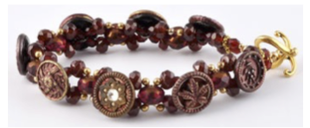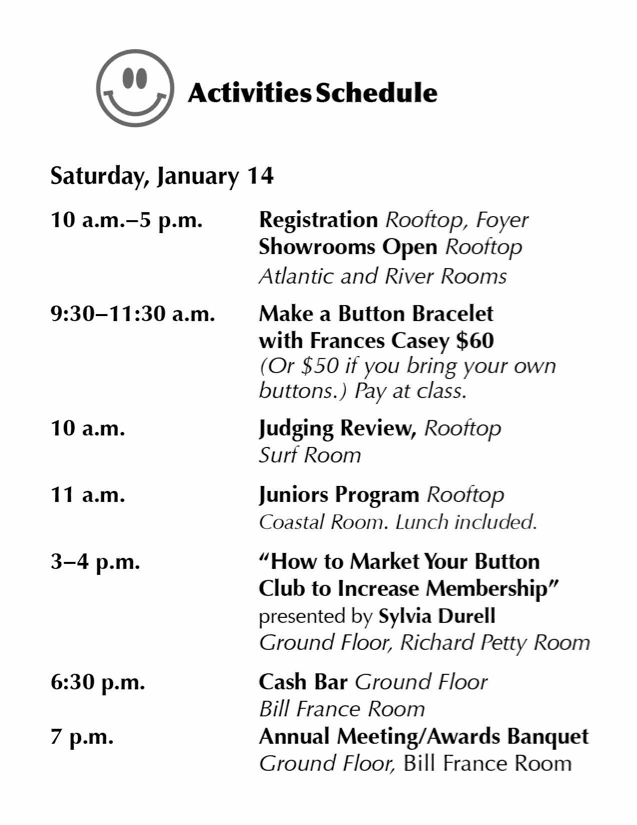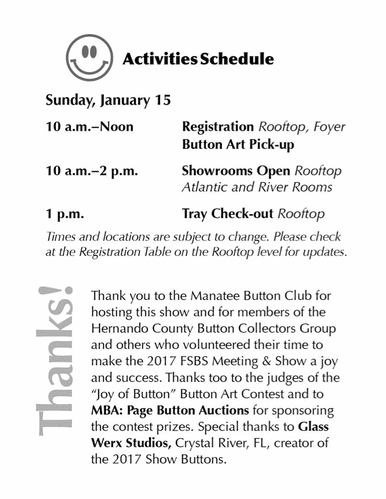
Below is a list of categories from which you can choose a favorite "H" or "I" button(s) to bring for "Show 'N Tell.". If there is not a website link with the description, you can try google-ing the term and add the word "images" to find photos of the type.
H. Smith: Connecticut button maker (1815). Name found on pewter buttons.
H.V. Allien & Co.: New York City makers of uniform buttons of all kinds (1870-1900). Name found on backs of buttons.
H. Young: American button maker before 1833. Name found on buttons.
Habitat Buttons: Buttons with plants and animal specimens under domed glass made in 18th century or early 19th century. Probably French. Usually with copper frame. Extremely rare.
Hair Buttons: Seldom found. Around 1817 hair was woven into web or net and fashioned with gold.
Hallmark: The official stamp on gold or silver. Most identifications need to be researched.
Hallmark Friendship Buttons: I just "discovered" these buttons and ordered some to bring to the meeting!
Hammond, Turner & Sons: English button manufacturers who made US Confederate buttons and sporting buttons of fine quality.
Handkerchief Corners: 19th century metal buttons that were cut square with corners bent over to the front. Maybe be 4 points or 8 points (if two squares were used). Sometimes called “Turned Corners.” www.worthpoint.com/worthopedia/large-cat-handkerchief-corner-button
Hawkeye Pearl Button Company: Made button blanks and fancy freshwater shell buttons in Muscatine Iowa. Were leaders of the industry for many years. www.muscatinehistory.org/whos-got-the-button
Haydens Company: Name appears fairly often on gilt and sporting buttons. Future generations manufactured tin pants buttons, flexible shank buttons, fabric-covered buttons and horn buttons.
Heinz Green Perkins: Buttons in realistic pickle shapes from Heinz Company are not really buttons. What is seen as a shank is actually where a pin was attached for fastening.
Heraldic: Two groups: (1) family coats-of-arms and crests; (2) dress buttons with parts of heraldic symbols. Usually made in metal, but in 20th century some were made in plastic.
Historic: Some buttons were designed specifically to commemorate historic occurrences. The category eventually evolved to include buttons that show things that no longer exist, like steamships, railways, etc.
Historical Wood Button: Made from the wood of a famous building, like the birthplace of Henry W. Longfellow or the national capitol building. Must have documentation.
Hollow Type: Two cupped pieces (home made from silver in the 1800s) that were braised together. Since then, others have been made of other metals by machines.
Holmes, Booth & Hayden Co.: Made brass buttons during the Civil War for military and civil uniforms.
Hoof: Usually ground up with horn and mixed with plastic and dyed. Generally more horn was used than hoof. Impossible to know if a horn button has any hoof in it.
Horn: Using moisture, heat and pressure, thin sheets of horn could be welded together or horn fragments could be molded. Two groups of horn buttons: Natural — cut from the solid parts of horn, shaped and polished. Some had self shanks; some had wire loop shanks or holes. Processed: — Made from the hollow of the horn. Other horn buttons were cut by hand or by machinery and decorated with metal or shell. No two were ever alike. www.buttoncountry.com/Horn1.html
Horsehair: A fabric woven from horses’ manes and tails. Usually used on horsehair furniture.
Horstmann and Horstmann, Brothers & Allien: Manufacturer’s name found on back of uniform buttons (1850s-1860s).
Hunt Club: Buttons made specifically for hunt club outfits, displaying club insignia.
Hunting Case: Two-piece Golden Age buttons that resembled hunting cases for watches.
Hyde and Goodrich: Of New Orleans, name found on southern state’s uniform buttons.
Hylas: Term for glass buttons decorated with single or multi-glass dots and/or line trim in contrasting colors. Usually in dome or cone shape with swirl back and wire shank. Now more often called Dot Trim or Overlay Trim.
Igloo: A Small China with raised center (looks like an igloo) that was with fused on a flat disk with two holes and sew-through under "igloo." www.pinterest.com/pin/122582421082206187/
Imitation Fabric: Molded designs imitating fabric, needlework, lace, cording, beading, etc.
Impression Inlay: Glass buttons with metal embellishments (such as rings, bracelets, small balls, realistic shapes, etc.) pressed into the glass while in a softened state.
Inanimate: Picture buttons showing inanimate objects like, nails, screws, hinges, locks, fences.
Inaugurals: Very few buttons were issued and authenticated to commemorate inaugurals. Exception: George Washington inaugural buttons. www.georgewashingtoninauguralbuttons.com/
India Rubber Comb Co.: Rubber buttons with marking I.R.C. CO., Goodyear 1851.
Indian Pottery: Native Americans made a few large (over 1-1/4”) convex buttons painted with black outlines and filled in with orange and brownish read. Most bought on reservations in 20th century.
Indian Silver: Two button categories: (1) Pawned: (worn by Native Americans and used as cash). Native American artisans have always preferred silver over gold, brass and copper. (2) Made for Market: Manufactured, stamped in latter years from a considerably thinner silver sheeting. Many forms and designs are available for collecting.
Inlay: Generally made of pieces of shell, ivory, bone, horn, wood, and vegetable ivory set into another material. Button disc is then sliced away from inlaid material.
Insects: Insects images are carved, molded, stamped or inlaid on buttons of nearly all materials.
Insets: Raised designs set into button disks.
Intaglio: Most commonly, designs that have been molded to be depressed into surface of button. Found a lot with black glass.
Israel, Jacobs: Maker of paperweight buttons. First buttons were made shankless but inserted into cup-like shanks. Later shanks made with wire with only one end of wire inserted into the glass. www.cmog.org/artwork/10-sulphide-paperweight-buttons
Ives, L.: Only plain pewter buttons have been found with this name.
Ivoroid: Two types of metal buttons with celluloid centers. Thin stamped designs (scenes, flowers heads, stories) and cutout designs (flowers).
Ivory: Elephant tusks provided the only true ivory but ivory buttons have also been made from tusks of hippos, walrus, narwhal and sperm whale. Ivory buttons with inlays of horn, shell or metals are also very collectible. Ivory buttons were also painted and stenciled.









 RSS Feed
RSS Feed